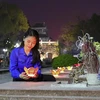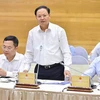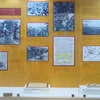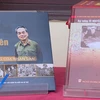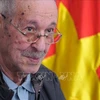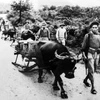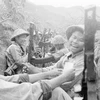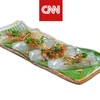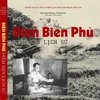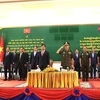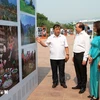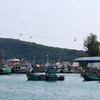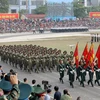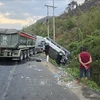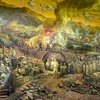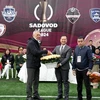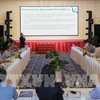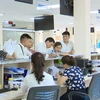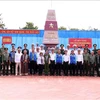Tet (Lunar New Year holiday), also known as “Tet ca” (biggest festival), is considered as the most important traditional festival in the whole country for people of the Kinh ethnicity.
Until the early 20 th century, Hanoians from all walks of life celebrated Tet in two stages: the preparatory stage and the enjoyment stage. During the preparatory stage, people brought gifts to important people in their lives and every family tidied up their house, cleaned their altars and objects used for worship, bought offerings, had new clothes made and so on.
In families that could afford to purchase many things for Tet, men went to Hang Ngang and Hang Duong Streets to buy “thuy tien” (narcissus) bulbs. Either the men or their daughters would care for the spring-time bulbs prior to Tet so that they would be in bloom on New Year’s Eve. If the men did not write their own couplet for the New Year, they went to Hang Bo Street to buy hand-scripted scrolls from old Confucian teachers, which were displayed in great numbers on the pavement. These paralled scrolls, were always written on red paper, unless the family was in mourning; if this were the case the scrolls had to be on yellow or green paper. Many men also went to Hang Luoc Street , when it was still a flower market in the 1920s, to buy flowers, branches of cherry or apricot blossoms, vases of camellia flowers, chrysanthemums or kumquats to decorate their houses for the holiday.
Women went to Hang Duong Street to buy cakes, sweets, sugar and preserved fruits. They also visited Hang Huong Street (now Hang Dau Street ) to buy assorted incense sticks and rings of incense such as sandalwood, musk, and eucalyptus. On Hang Buom and Hang Can Streets they found vermicelli, bamboo shoots and mushrooms. Many ladies went to Hang Quat Street (now Luong Van Can Street ) as early as in the tenth lunar month to order made-to-measure brocade robes or satin tunics. Tailored clothing was also commonly ordered in Trach Xa Village (Ung Hoa district on the outskirts of Hanoi now). The women also ventured to Hang Bac Street to have the merchants there give their jewellery a beautiful shine.
However, the first thing all families thought about as they prepared for Tet was making their own batches of “banh chung” (square cakes made of glutinous rice with mung bean and pork as filling). The ritual of preparing the cakes was pure happiness for most families – wrapping the dumplings in rush leaves, boiling them and watching them until they looked just about right, and then breaking open the first one for the first taste test.
People also prepared meat pies wrapped in banana leaves. Meticulous people would pound out the lean meat pies themselves, and if they were even more meticulous, they would arrange pieces of boiled chicken eggs in the shape of a lemon flower in the middle of the meat pie. When the pie was later sliced into individual portions, each had a flower in the centre. Meat pies were also available in most markets if people did not have the desire or time to prepare their own.
Special items for the Tet banquet also had to be purchased. Even poor families couldn’t do without lean meat pies, spring rolls, and “moc” (steamed lean pork balls). More luxurious items included cooked fish such as conger pike, mackerel, fin, shell-fish, seaweed and salangane.
Apart from the cooked food banquet, there was also the confectionery banquet. A pot of green bean compote, an earthenware pan of dumplings, sweet potato cakes and assorted jams such as ginger, kumquat and lotus seed were also considered essential.
Whether in Hanoi or in the country, people enjoyed Tet together. On Tet’s Eve, a tray of ritual offerings was prepared for worship. On the first day of the first lunar month, the offering was the first course of business. Children would then go home and wish their parents and grand-parents a happy New Year. Close friends and kin visited each other’s homes to wish each other a happy New Year. Every family, whether rich or poor, was happy at the first dinner of the new year because “they could stay hungry when they organised their fathers’ death ceremony, but during the three days of Tet, they had to be full.”
Because of the celebratory mood, the three days of Tet passed by with best wishes exchanged amid fireworks and firecrackers, and public games around Hoan Kiem Lake . Other family games such as cards and mahjong were also played during these days. But the happiest people at Tet were the children, who proudly put on their new clothes and received New Year’s wishes and lucky money.
Over the past fifty years, the customs for welcoming Tet have changed. Some changes were seen during the American War and then post-war period.
Despite many difficulties during the war, the Government took care of the people so that they could enjoy their traditional Tet days with additional rations of food and other necessities. Tet rations included meat, glutinous rice and green beans, more packets of tea, boxes of assorted jams, and even extra dried pig skin. Large quantities of rush leaves were collected from the forests and distributed to people to wrap their “banh chung”. At that time, the State also supplied people in urban areas with the fuel they so desperately needed. In short, all of the traditional Tet customs were maintained.
These days, people’s lives have become even better. Food is plentiful. “Banh chung” can be purchased in many shops, so people don’t need to spend time on its meticulous preparations. In fact, “banh chung” is now available all year round, not only during Tet as in the past. One can always see people these days wearing good and fashionable dresses all over the city. So now during Tet people spend their time visiting friends and enjoying various forms of entertainment. The old customs that remain are the wishes for a happy New Year, offerings made to ancestors on the morning of the first day of Lunar January and the ceremony of burning votive money for the dead on the third or fourth day.
It is worth noting that for the past decade firecrackers have been banned for safety reasons, to positive response and acceptance by the people. It has also become popular for people from the city to take domestic tours during the holiday and some wealthy families even travel abroad.
Another prominent custom appeared in 1955 and has since become a tradition. Hanoians celebrate New Year’s Eve around Hoan Kiem Lake .
The first New Year’s Eve fireworks display was also organised on the shores of the lake. After people heard New Year’s wishes from President Ho Chi Minh on the radio, the fireworks festival became special to everyone in the city. This event has become a fine custom for people in the city, which sees them flock to Hoan Kiem Lake to welcome spring with all their hearts./.
Until the early 20 th century, Hanoians from all walks of life celebrated Tet in two stages: the preparatory stage and the enjoyment stage. During the preparatory stage, people brought gifts to important people in their lives and every family tidied up their house, cleaned their altars and objects used for worship, bought offerings, had new clothes made and so on.
In families that could afford to purchase many things for Tet, men went to Hang Ngang and Hang Duong Streets to buy “thuy tien” (narcissus) bulbs. Either the men or their daughters would care for the spring-time bulbs prior to Tet so that they would be in bloom on New Year’s Eve. If the men did not write their own couplet for the New Year, they went to Hang Bo Street to buy hand-scripted scrolls from old Confucian teachers, which were displayed in great numbers on the pavement. These paralled scrolls, were always written on red paper, unless the family was in mourning; if this were the case the scrolls had to be on yellow or green paper. Many men also went to Hang Luoc Street , when it was still a flower market in the 1920s, to buy flowers, branches of cherry or apricot blossoms, vases of camellia flowers, chrysanthemums or kumquats to decorate their houses for the holiday.
Women went to Hang Duong Street to buy cakes, sweets, sugar and preserved fruits. They also visited Hang Huong Street (now Hang Dau Street ) to buy assorted incense sticks and rings of incense such as sandalwood, musk, and eucalyptus. On Hang Buom and Hang Can Streets they found vermicelli, bamboo shoots and mushrooms. Many ladies went to Hang Quat Street (now Luong Van Can Street ) as early as in the tenth lunar month to order made-to-measure brocade robes or satin tunics. Tailored clothing was also commonly ordered in Trach Xa Village (Ung Hoa district on the outskirts of Hanoi now). The women also ventured to Hang Bac Street to have the merchants there give their jewellery a beautiful shine.
However, the first thing all families thought about as they prepared for Tet was making their own batches of “banh chung” (square cakes made of glutinous rice with mung bean and pork as filling). The ritual of preparing the cakes was pure happiness for most families – wrapping the dumplings in rush leaves, boiling them and watching them until they looked just about right, and then breaking open the first one for the first taste test.
People also prepared meat pies wrapped in banana leaves. Meticulous people would pound out the lean meat pies themselves, and if they were even more meticulous, they would arrange pieces of boiled chicken eggs in the shape of a lemon flower in the middle of the meat pie. When the pie was later sliced into individual portions, each had a flower in the centre. Meat pies were also available in most markets if people did not have the desire or time to prepare their own.
Special items for the Tet banquet also had to be purchased. Even poor families couldn’t do without lean meat pies, spring rolls, and “moc” (steamed lean pork balls). More luxurious items included cooked fish such as conger pike, mackerel, fin, shell-fish, seaweed and salangane.
Apart from the cooked food banquet, there was also the confectionery banquet. A pot of green bean compote, an earthenware pan of dumplings, sweet potato cakes and assorted jams such as ginger, kumquat and lotus seed were also considered essential.
Whether in Hanoi or in the country, people enjoyed Tet together. On Tet’s Eve, a tray of ritual offerings was prepared for worship. On the first day of the first lunar month, the offering was the first course of business. Children would then go home and wish their parents and grand-parents a happy New Year. Close friends and kin visited each other’s homes to wish each other a happy New Year. Every family, whether rich or poor, was happy at the first dinner of the new year because “they could stay hungry when they organised their fathers’ death ceremony, but during the three days of Tet, they had to be full.”
Because of the celebratory mood, the three days of Tet passed by with best wishes exchanged amid fireworks and firecrackers, and public games around Hoan Kiem Lake . Other family games such as cards and mahjong were also played during these days. But the happiest people at Tet were the children, who proudly put on their new clothes and received New Year’s wishes and lucky money.
Over the past fifty years, the customs for welcoming Tet have changed. Some changes were seen during the American War and then post-war period.
Despite many difficulties during the war, the Government took care of the people so that they could enjoy their traditional Tet days with additional rations of food and other necessities. Tet rations included meat, glutinous rice and green beans, more packets of tea, boxes of assorted jams, and even extra dried pig skin. Large quantities of rush leaves were collected from the forests and distributed to people to wrap their “banh chung”. At that time, the State also supplied people in urban areas with the fuel they so desperately needed. In short, all of the traditional Tet customs were maintained.
These days, people’s lives have become even better. Food is plentiful. “Banh chung” can be purchased in many shops, so people don’t need to spend time on its meticulous preparations. In fact, “banh chung” is now available all year round, not only during Tet as in the past. One can always see people these days wearing good and fashionable dresses all over the city. So now during Tet people spend their time visiting friends and enjoying various forms of entertainment. The old customs that remain are the wishes for a happy New Year, offerings made to ancestors on the morning of the first day of Lunar January and the ceremony of burning votive money for the dead on the third or fourth day.
It is worth noting that for the past decade firecrackers have been banned for safety reasons, to positive response and acceptance by the people. It has also become popular for people from the city to take domestic tours during the holiday and some wealthy families even travel abroad.
Another prominent custom appeared in 1955 and has since become a tradition. Hanoians celebrate New Year’s Eve around Hoan Kiem Lake .
The first New Year’s Eve fireworks display was also organised on the shores of the lake. After people heard New Year’s wishes from President Ho Chi Minh on the radio, the fireworks festival became special to everyone in the city. This event has become a fine custom for people in the city, which sees them flock to Hoan Kiem Lake to welcome spring with all their hearts./.
